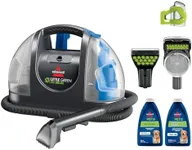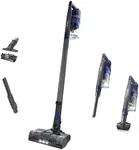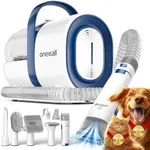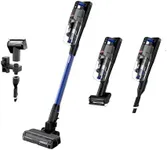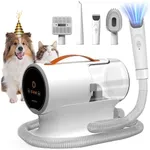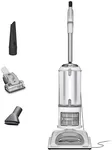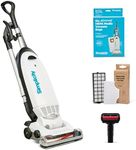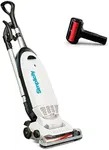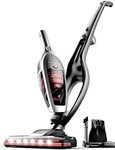Buying Guide for the Best Pet Vacuum For Dogs
Choosing the right pet vacuum for dogs can make a significant difference in maintaining a clean home and ensuring your pet's comfort. When selecting a pet vacuum, it's important to consider various features that cater to your specific needs and the needs of your dog. Here are some key specifications to look out for and how to navigate them to find the best fit for you and your furry friend.Suction PowerSuction power determines how effectively the vacuum can pick up pet hair, dirt, and debris. This is crucial for homes with dogs, especially those that shed a lot. Suction power is often measured in watts or air watts. Higher suction power (above 200 air watts) is ideal for heavy shedding breeds, while moderate suction power (100-200 air watts) can suffice for dogs that shed less. Consider your dog's shedding level and the types of surfaces in your home when choosing the suction power.
Filtration SystemA good filtration system ensures that allergens and fine particles are trapped inside the vacuum, preventing them from being released back into the air. This is particularly important for households with allergy sufferers. HEPA filters are the gold standard, capturing 99.97% of particles as small as 0.3 microns. If allergies are a concern, opt for a vacuum with a HEPA filter. For general use, a vacuum with a high-efficiency filter can also be effective.
Brush RollThe brush roll is the part of the vacuum that agitates and lifts pet hair from carpets and upholstery. Look for a vacuum with a tangle-free brush roll to prevent hair from wrapping around it, which can reduce efficiency and require frequent cleaning. For homes with multiple types of flooring, a vacuum with an adjustable or multi-surface brush roll is ideal. Consider your flooring type and the amount of pet hair when selecting the brush roll.
Attachments and AccessoriesAttachments and accessories can enhance the versatility of your vacuum. Common attachments for pet vacuums include motorized pet tools, crevice tools, and upholstery brushes. These can help you clean hard-to-reach areas, furniture, and car interiors. If you have a dog that sheds heavily or has long hair, look for vacuums with specialized pet hair attachments. Think about the areas you need to clean and choose a vacuum with the appropriate accessories.
Noise LevelDogs can be sensitive to loud noises, so a quieter vacuum can make the cleaning process less stressful for your pet. Noise levels are measured in decibels (dB). Vacuums with noise levels below 70 dB are considered quiet. If your dog is particularly anxious around loud noises, prioritize a vacuum with a lower noise level. Consider your dog's temperament and how they react to noise when choosing a vacuum.
ManeuverabilityManeuverability refers to how easily you can move the vacuum around your home. This includes the vacuum's weight, swivel steering, and cord length. Lightweight vacuums (under 15 pounds) are easier to carry and maneuver, especially in multi-level homes. Swivel steering allows for better control around furniture and tight spaces. A longer cord (over 25 feet) can reduce the need to switch outlets frequently. Consider the layout of your home and your physical ability when evaluating maneuverability.
Bagged vs. BaglessPet vacuums come in both bagged and bagless designs. Bagged vacuums use disposable bags to collect dirt and hair, which can be more hygienic and reduce exposure to allergens. Bagless vacuums use a dustbin that needs to be emptied regularly, which can be more cost-effective and environmentally friendly. If you prefer less frequent maintenance and better allergen control, a bagged vacuum may be better. If you want to avoid the ongoing cost of bags, a bagless vacuum could be the right choice.

